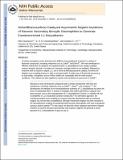| dc.contributor.author | Do, Hien-Quang | |
| dc.contributor.author | Chandrashekar, E. R. R. | |
| dc.contributor.author | Fu, Gregory C | |
| dc.date.accessioned | 2018-01-26T16:08:35Z | |
| dc.date.available | 2018-01-26T16:08:35Z | |
| dc.date.issued | 2013-10 | |
| dc.date.submitted | 2013-08 | |
| dc.identifier.issn | 0002-7863 | |
| dc.identifier.issn | 1520-5126 | |
| dc.identifier.uri | http://hdl.handle.net/1721.1/113309 | |
| dc.description.abstract | A tertiary stereogenic center that bears two different aryl substituents is found in a variety of bioactive compounds, including medicines such as Zoloft and Detrol. We have developed an efficient method for the synthesis of enantioenriched 1,1-diarylalkanes from readily available racemic benzylic alcohols. Formation of a benzylic mesylate (which is not isolated), followed by treatment with an arylzinc reagent, LiI, and a chiral nickel/bis(oxazoline) catalyst, furnishes the Negishi cross-coupling product in high ee and good yield. A wide array of functional groups (e.g., an aryl iodide, a thiophene, and an N-Boc-indole) are compatible with the mild reaction conditions. This method has been applied to a gram-scale synthesis of a precursor to Zoloft. | en_US |
| dc.description.sponsorship | National Institute of General Medical Sciences (U.S.) (Grant R01-GM62871) | en_US |
| dc.publisher | American Chemical Society (ACS) | en_US |
| dc.relation.isversionof | http://dx.doi.org/10.1021/JA408561B | en_US |
| dc.rights | Article is made available in accordance with the publisher's policy and may be subject to US copyright law. Please refer to the publisher's site for terms of use. | en_US |
| dc.source | PMC | en_US |
| dc.title | Nickel/Bis(oxazoline)-Catalyzed Asymmetric Negishi Arylations of Racemic Secondary Benzylic Electrophiles to Generate Enantioenriched 1,1-Diarylalkanes | en_US |
| dc.type | Article | en_US |
| dc.identifier.citation | Do, Hien-Quang et al. “Nickel/Bis(oxazoline)-Catalyzed Asymmetric Negishi Arylations of Racemic Secondary Benzylic Electrophiles to Generate Enantioenriched 1,1-Diarylalkanes.” Journal of the American Chemical Society 135, 44 (October 2013): 16288–16291 © 2013 American Chemical Society | en_US |
| dc.contributor.department | Massachusetts Institute of Technology. Department of Chemistry | en_US |
| dc.contributor.mitauthor | Chandrashekar, E. R. R. | |
| dc.contributor.mitauthor | Fu, Gregory C | |
| dc.relation.journal | Journal of the American Chemical Society | en_US |
| dc.eprint.version | Author's final manuscript | en_US |
| dc.type.uri | http://purl.org/eprint/type/JournalArticle | en_US |
| eprint.status | http://purl.org/eprint/status/PeerReviewed | en_US |
| dc.date.updated | 2018-01-24T15:12:24Z | |
| dspace.orderedauthors | Do, Hien-Quang; Chandrashekar, E. R. R.; Fu, Gregory C. | en_US |
| dspace.embargo.terms | N | en_US |
| mit.license | PUBLISHER_POLICY | en_US |
